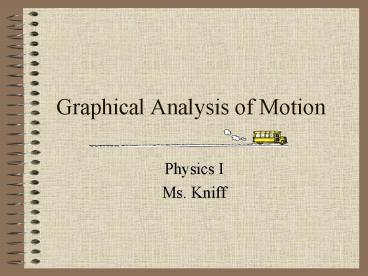Graphical Analysis of Motion PowerPoint PPT Presentation
1 / 29
Title: Graphical Analysis of Motion
1
Graphical Analysis of Motion
- Physics I
- Ms. Kniff
2
Analyzing Motion Using Graphs
- Distance vs. Time Graphs
- Velocity vs. Time Graphs
- Acceleration vs. Time Graphs
- and..how the graphs are related
- and..what the graphs tell us
3
Case 1 Truck Standing Still
- d
vs. t
distance
time
4
How do these graphs relate?
Remember v Dd/D t slope rise/run
for a d vs. t graph. slope Dd/Dt
velocity Therefore, the slope of a d vs. t graph
is velocity.
And.. a Dv/Dt slope rise/run
for a v vs. t graph. slope Dv/Dt
acceleration Therefore, the slope of a v vs. t
graph is acceleration.
5
Case 1 Truck Standing Still
- v vs. t a
vs. t
acceleration
velocity
time
time
6
Case 2 Truck Moving Forward at a Constant
Velocity
-
d vs. t
distance
time
7
How do these graphs relate?
- The slope of a d vs. t graph is velocity.
- The slope of a v vs. t graph is acceleration.
8
Case 2 Truck Moving Forward at a Constant
Velocity
- v vs. t a vs. t
velocity
acceleration
time
time
9
Case 3 Truck Accelerating Forward
- d vs. t
distance
time
10
How do these graphs relate?
- The slope of a d vs. t graph is velocity.
- The slope of a v vs. t graph is acceleration.
11
Case 3 Truck Accelerating Forward
- v vs. t a
vs. t
acceleration
velocity
time
time
12
EXAMPLE - Summarizing Cases 1,2,3
d vs t
B
C
distance
A
D
time
- AB - Constant Velocity Forward
- BC - No distance - Stopped
- CD - Neg Slope - Const Vel Backward
13
EXAMPLE - Summarizing Cases 1,2,3(what if this
graph was v vs. t?)
v vs t
B
C
velocity
A
D
time
- AB - Inc.Velocity or Acceleration Forward
- BC - Constant Velocity
- CD - Dec.Velocity or Decel. Forward
14
Is this everything that we need to know? What if
we change direction? (Sign Convention)
15
Distance vs. TimeConstant Velocity (Sign
Convention)
Const. Vel. Forward
Stopped
Const. Vel. Backward
d
t
Const. Vel. Forward
-
Stopped
Const. Vel. Backward
16
Distance vs. TimeAccelerated Motion (Sign
Convention)
Accelerating Forward ( )
Decelerating Forward (- -)
d
t
-
Decelerating Backward (- - )
Accelerating Backward ( - -)
17
Velocity vs. Time (Sign Convention)
Inc. Vel. (Accel) Forward
forward
Const. Vel. Forward
Dec. Vel. (Decel) Forward
v
t
Dec. Vel. (Decel.) Backward
Const. Vel. Backward
backward
Inc. Vel. (Accel.) Backward
18
EXAMPLE Complete Trip Graph
d
c
d
b
e
a
h
- a) constant velocity forward
- b) deceleration forward
- c) stopped
- d) constant velocity forward
- e) constant velocity backward
- f) deceleration backward
- g) constant velocity forward
- h) stopped at pt of origin
t
f
g
19
Lets Review
d
Case 1 STOPPED
t
Slope
v
t
a
t
20
Lets Review
d
Case 2 Constant Velocity
t
Slope
v
t
a
t
21
Lets Review
Its more difficult to find the slope of a curve,
draw a tangent to the curve and find the slope of
the tangent line.
d
Case 3 Uniform Acceleration
t
Slope
v
t
a
t
22
EXAMPLE
d
t
Which line represents the larger velocity?
The steeper the line, the larger the slope,
therefore the greater the velocity.
23
Area of a Motion Time Graph
We can also use the area under the curve to
relate these graphs.
a
t
Area of a rectangle (l)(w) Area of an
acceleration vs time graph Area (a)(t)
(v/t)(t) v Therefore, the area under an a vs. t
graph is the velocity.
24
Area of a Motion Time Graph
We can also use the area under the curve to
relate these graphs.
v
t
Area of a triangle ½(b)(h) Area of a velocity vs
time graph Area ½(t)(v) ½(t)(at) ½at2
d Therefore, the area under a v vs. t graph is
the distance.
25
Lets Summarize Slope and Area
d
t
slope
area
v
t
a
t
26
Analyzing Motion Graphs - REVIEWPosition vs.
Time Graphs
- Displacement is read from the vertical scale.
- Velocity is found from the slope of the graph.
- Average velocity is the slope of the line
connecting two points on the graph. - Instantaneous velocity is the slope of a line
drawn tangent to the curve at a specific time.
27
Analyzing Motion Graphs - REVIEWVelocity vs.
Time Graphs
- Displacement is the area under the graph.
- Velocity is read from the vertical scale.
- Acceleration is found from the slope of the
graph. - Average acceleration is the slope of the line
connecting two points on the graph. - Instantaneous acceleration is the slope of a line
drawn tangent to the curve at a specific time.
28
Analyzing Motion Graphs - REVIEWAcceleration vs.
Time Graphs
- Velocity is the area under the graph.
- Acceleration is read from the vertical scale.
29
Now that we know how it works..
- Any questions?
- Lets try some examples.

